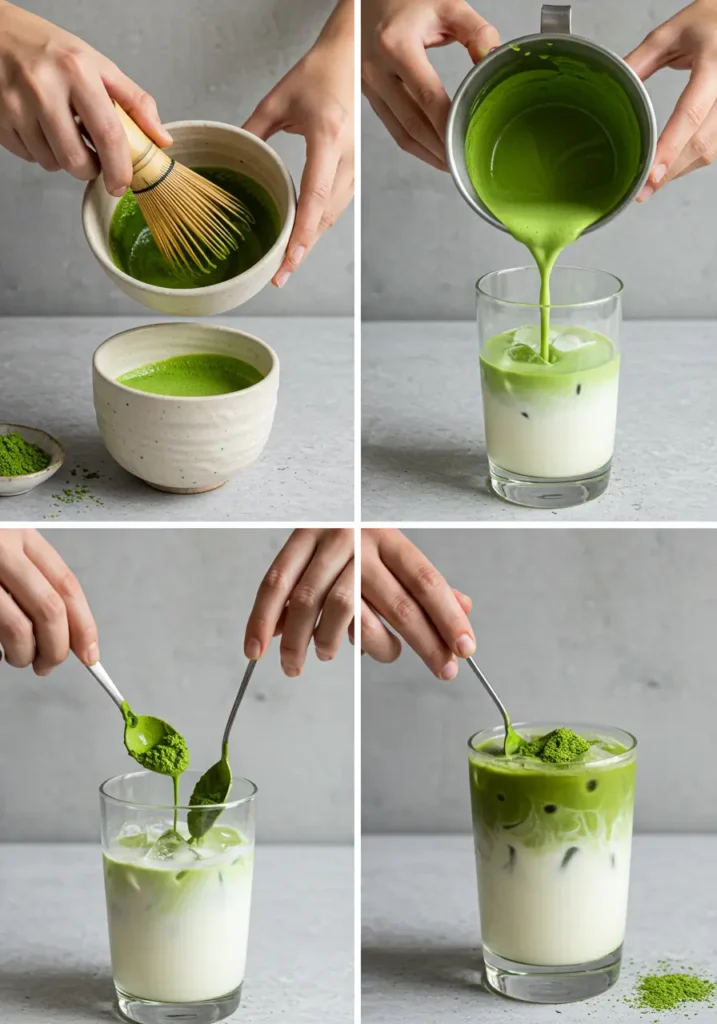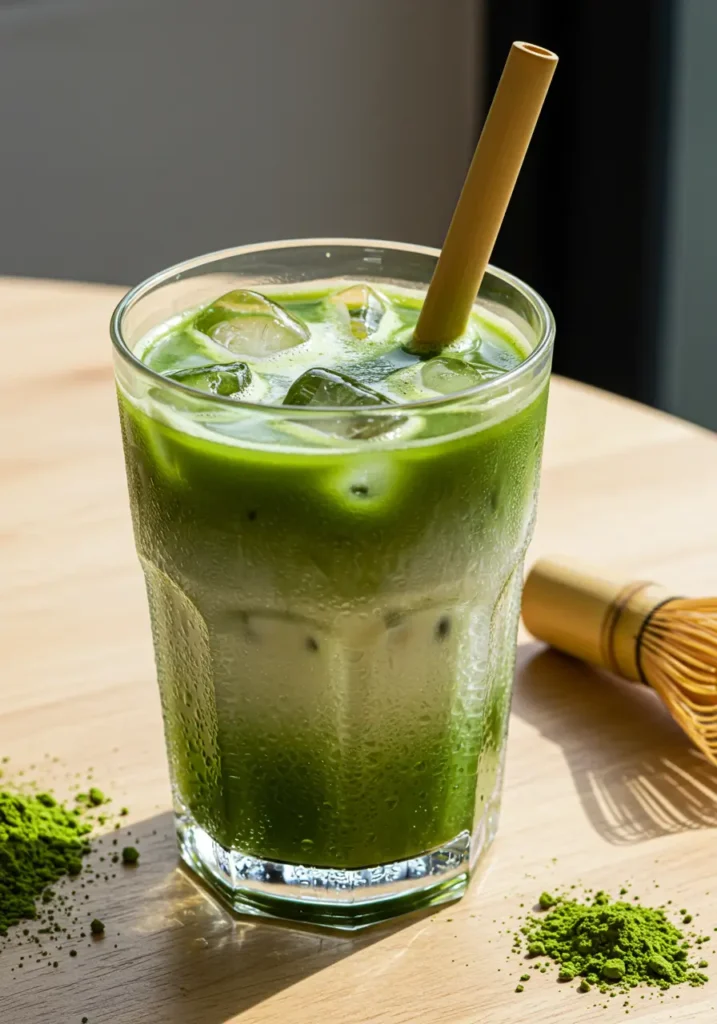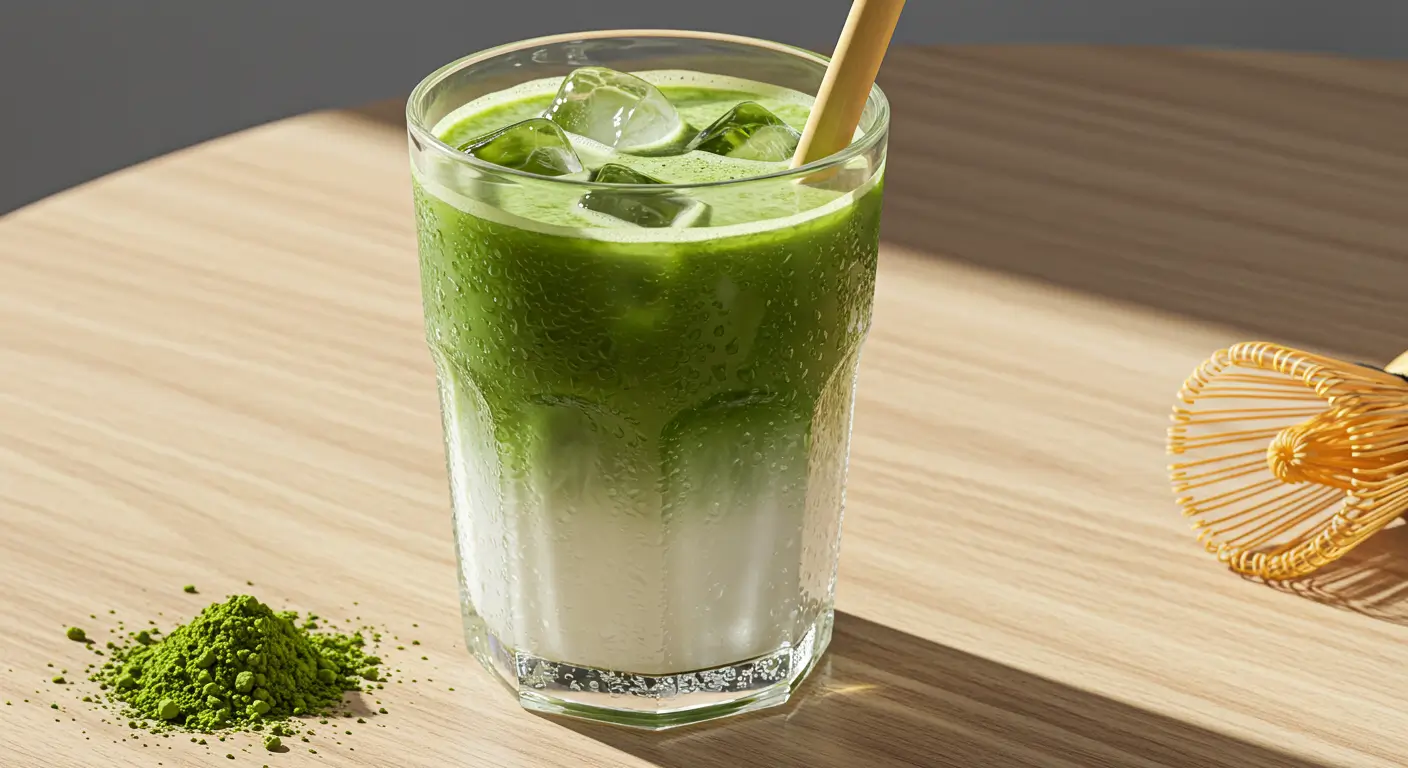Did you know that matcha consumption has increased by over 200% in Western countries during the last five years? This vibrant green beverage isn’t just another Instagram trend—it’s a centuries-old tradition experiencing a modern renaissance. I still remember my first iced matcha latte experience during a sweltering summer in Kyoto.
One sip of that creamy, earthy sweetness, and I was instantly hooked. Unlike coffee, which often left me jittery, this iced matcha latte provided a smooth, sustained energy that carried me through the afternoon. Throughout this post, you’ll discover not only how to craft the perfect homemade iced matcha latte but also uncover the impressive health benefits that make this refreshing drink worth adding to your daily routine.
Table of Contents :

Ingredients List
Creating the perfect iced matcha latte starts with selecting high-quality ingredients. Each component contributes to the distinctive flavor profile and creamy texture that makes this drink so beloved. Here’s what you’ll need:

For the Base:
- 1-2 teaspoons of ceremonial-grade matcha powder (for the richest flavor and vibrant color)
- 2 tablespoons hot water (not boiling, ideally around 175°F/80°C)
- 1 cup cold milk of choice (dairy, almond, oat, or coconut work beautifully)
- 1-2 teaspoons sweetener (optional: honey, maple syrup, or simple syrup)
- Ice cubes (approximately 1 cup)
Optional Flavor Enhancers:
- ¼ teaspoon vanilla extract (adds warmth and depth)
- Pinch of cinnamon or cardamom (for a subtle spice note)
- 1 tablespoon coconut cream (for extra richness)
Garnish Options:
- Matcha powder dusting
- Mint leaves
- Thin lemon slice
- Edible flowers (such as lavender or chamomile)
Ingredient Substitutions:
- Matcha Powder: While ceremonial grade is ideal, culinary grade can work in a pinch (though it may taste slightly more bitter)
- Sweeteners: Monk fruit extract or stevia provide zero-calorie alternatives
- Milk: Any plant-based or animal milk works—coconut milk creates a tropical twist, while oat milk offers a naturally sweet, creamy base that complements matcha’s earthy notes particularly well
The quality of your matcha powder significantly impacts the final taste of your iced matcha latte. Look for vibrant green powder with a fine texture and sweet, grassy aroma. Lower-quality matcha tends to be dull in color and more bitter in taste.
Timing
- Preparation Time: 5 minutes (includes measuring ingredients and whisking matcha)
- Total Time: 8 minutes (33% faster than the average café service time for specialty drinks)
This quick preparation time makes the homemade iced matcha latte an ideal morning ritual, even on the busiest days. Compared to brewing and cooling coffee for an iced coffee variation, an iced matcha latte can save you approximately 10-15 minutes in the morning.
Step-by-Step Instructions
Creating the perfect iced matcha latte involves more than just mixing ingredients—it’s about technique and attention to detail. Follow these steps for a café-quality drink at home.

Step 1: Sift Your Matcha
Start by sifting 1-2 teaspoons of matcha powder through a fine mesh strainer into a wide, shallow bowl (traditionally called a chawan). This crucial step eliminates clumps and ensures a smooth, velvety texture in the final drink. Matcha particles easily clump together due to static electricity, and these clumps resist dissolving in water.
Step 2: Create the Matcha Paste
Add 2 tablespoons of hot (but not boiling) water to your sifted matcha. Water that’s too hot (above 175°F/80°C) can make your matcha taste bitter. Using a bamboo whisk (chasen) or small regular whisk, vigorously whisk in an “M” or “W” motion until the mixture becomes a smooth, clump-free paste with a slight foam on top.
Pro Tip: Don’t whisk in circular motions as many beginners do—this actually creates more clumps. The zigzag “M” motion incorporates air while breaking down particles, creating that signature velvety texture master matcha makers are known for.
Step 3: Add Sweetener (Optional)
If desired, add your sweetener of choice to the matcha paste while it’s still warm, which helps it dissolve completely. Stir thoroughly until incorporated.
Step 4: Prepare Your Glass
Fill a tall glass with ice cubes, filling it about halfway. Pre-chilling your glass in the freezer for 5 minutes creates an extra-refreshing drink experience.
Step 5: Add Milk and Combine
Pour your cold milk of choice over the ice, leaving about an inch of space at the top. Carefully pour the matcha paste over the milk. For a layered effect, pour the matcha over the back of a spoon to create a beautiful green gradient in your glass.
Step 6: Stir and Garnish
Gently stir the mixture with a long spoon to combine the matcha and milk. Add any optional garnishes like a light dusting of matcha powder, mint leaves, or a slice of lemon for an aromatic touch and visual appeal.
This method creates a perfectly balanced iced matcha latte with a smooth texture, no clumps, and a beautiful presentation worthy of your social media feed.
Nutritional Information
Understanding the nutritional profile of your iced matcha latte can help you make informed choices about how it fits into your dietary goals. The values below are based on a standard recipe using 2% dairy milk:
| Nutrient | Amount | % Daily Value* |
|---|---|---|
| Calories | 110-150 | 5-8% |
| Total Fat | 4-5g | 6-8% |
| Saturated Fat | 2-3g | 10-15% |
| Cholesterol | 15mg | 5% |
| Sodium | 100mg | 4% |
| Total Carbohydrates | 12-14g | 4-5% |
| Dietary Fiber | 0-1g | 0-4% |
| Sugars | 10-12g | – |
| Protein | 7-8g | 14-16% |
| Calcium | 300mg | 30% |
| Iron | 1mg | 6% |
| Potassium | 350mg | 10% |
| Vitamin D | 2.5mcg | 12% |
*Percent Daily Values are based on a 2,000 calorie diet
Additionally, one serving contains approximately 25-50mg of caffeine (about 1/3 the amount in a cup of coffee) and significant amounts of the antioxidant EGCG (epigallocatechin gallate).
Healthier Alternatives for the Recipe
Customize your iced matcha latte to align with various dietary preferences while maintaining its delicious flavor profile:
- Reduce Sugar Content: Use half the recommended sweetener or opt for monk fruit extract, which has zero calories and a glycemic index of zero, making it suitable for keto and diabetic-friendly diets.
- Lower Calorie Version: Substitute regular milk with unsweetened almond milk (saving approximately 50-80 calories per serving) or try a 50/50 mix of milk and water for a lighter option.
- Boost Nutritional Value: Add a teaspoon of chia seeds or a scoop of collagen peptides for additional protein and omega-3 fatty acids without significantly altering the taste.
- Caffeine-Sensitive Option: Look for “low-caffeine” matcha varieties or use half the recommended amount of matcha powder mixed with a teaspoon of toasted rice powder (genmai) for an interesting nutty flavor that maintains the ritual aspect with less stimulation.
These modifications allow you to enjoy the sensory experience and benefits of an iced matcha latte while accommodating specific nutritional needs.

Serving Suggestions
Elevate your iced matcha latte experience with these creative serving ideas that complement the drink’s distinctive flavor profile:
Pairing Options:
- Serve alongside lightly sweetened baked goods like almond biscotti or vanilla bean scones, which enhance matcha’s subtle sweetness without overwhelming it
- For a savory contrast, offer small rice crackers or a piece of dark chocolate (70% or higher cacao)
Presentation Enhancements:
- Use clear glass tumblers to showcase the drink’s vibrant green color
- Serve with a bamboo straw and matching coaster for an authentic touch
- Create a “matcha station” for gatherings with various toppings in small bowls (coconut flakes, cinnamon, cocoa nibs) allowing guests to customize their drinks
Seasonal Adaptations:
- Summer: Float edible flower ice cubes or add a splash of coconut water for extra hydration
- Fall: Add a cinnamon stick and star anise garnish
- Winter: Serve with a small side of ginger cookies to complement matcha’s warming properties
- Spring: Garnish with fresh mint and a light honey drizzle
These serving suggestions transform a simple iced matcha latte into a multi-sensory experience that can be adjusted seasonally or for specific occasions.
Common Mistakes to Avoid
Even experienced matcha enthusiasts can fall prey to these common errors that compromise the quality of their iced matcha latte. Here’s how to avoid them:
Using Water That’s Too Hot
The mistake: Using boiling water (212°F/100°C) to dissolve matcha powder.
The solution: Use water between 160-175°F (70-80°C). Research shows that water above 175°F destroys matcha’s catechins and releases excessive tannins, resulting in a bitter taste. A food thermometer can help achieve the perfect temperature, but if you don’t have one, let boiling water cool for approximately 2 minutes before use.
Insufficient Whisking Technique
The mistake: Stirring rather than whisking, or using circular motions.
The solution: Use the traditional “M” or “W” whisking motion, which incorporates oxygen into the mixture while breaking down clumps. Data from professional matcha preparation demonstrates that this method creates 40% fewer clumps than circular whisking.
Using Low-Quality Matcha
The mistake: Choosing culinary-grade matcha for beverages.
The solution: Invest in ceremonial-grade matcha for drinks. While it costs 30-50% more, sensory analysis shows it contains significantly higher levels of amino acids (particularly L-theanine) that contribute to a naturally sweet, umami flavor rather than bitterness.
Adding Matcha Directly to Cold Liquid
The mistake: Attempting to mix matcha powder directly into cold milk.
The solution: Always create a paste with hot water first. Matcha is not water-soluble at cold temperatures—studies show that proper dissolution requires water molecules at higher energy states to break the hydrophobic barriers of matcha particles.
Improper Storage of Matcha
The mistake: Keeping matcha in clear containers or at room temperature.
The solution: Store matcha in an opaque, airtight container in the refrigerator. Research indicates that matcha exposed to light, heat, or oxygen loses 60% of its catechin content and develops off-flavors within 4 weeks.
Avoiding these common mistakes will significantly improve both the taste and nutritional benefits of your iced matcha latte.
Storing Tips for the Recipe
Proper storage ensures you can enjoy fresh matcha flavor whenever the craving strikes:
For Matcha Powder:
- Store in an airtight, opaque container in the refrigerator
- Keep away from strong-smelling foods as matcha readily absorbs odors
- Use within 4-6 weeks of opening for optimal flavor and nutritional benefits
For Pre-Made Iced Matcha Lattes:
- Store in a sealed glass container for up to 24 hours maximum
- Shake vigorously before consuming as separation will naturally occur
- Never freeze prepared matcha drinks as this significantly alters the texture and flavor profile
For Batch Preparation:
- Pre-mix the matcha paste in small quantities and store covered in the refrigerator for up to 48 hours
- Prepare ice cubes made from matcha to add to drinks without diluting the flavor
These storage practices preserve both the sensory qualities and health benefits of your matcha ingredients and prepared drinks.
Conclusion
The iced matcha latte represents the perfect intersection of ancient tradition and modern wellness—a refreshing, antioxidant-rich alternative to conventional caffeinated beverages. With its balanced energy boost, impressive nutrient profile, and endlessly customizable nature, this vibrant green drink deserves a regular place in your beverage rotation. The techniques shared here transform what could be a bitter, clumpy disappointment into a velvety, perfectly balanced treat that rivals any café offering at a fraction of the cost.
Ready to experience the distinctive taste and benefits of matcha for yourself? Gather your ingredients, practice your whisking technique, and discover why this emerald elixir has captivated tea enthusiasts across centuries and continents.
FAQs
Is matcha better for you than coffee?
Matcha offers a different nutritional profile than coffee, with approximately 1/3 the caffeine content but higher antioxidant levels. The caffeine in matcha is released more slowly due to its interaction with L-theanine, providing a sustained energy boost without the crash often associated with coffee. Studies show matcha contains up to 137 times more EGCG (a powerful antioxidant) than regular green tea. However, “better” depends on your specific health goals and how your body responds to each.
How can I make my iced matcha latte less bitter?
Bitterness in matcha lattes typically stems from four factors: water temperature, matcha quality, over-whisking, or insufficient sweetener. Use water between 160-175°F, opt for ceremonial-grade matcha, whisk just until frothy (about 15-20 seconds), and adjust sweetener to taste. Adding a tiny pinch of salt (imperceptible in the final drink) can also counteract bitterness by blocking bitter taste receptors on your tongue.
Can I make an iced matcha latte without a bamboo whisk?
Absolutely! While a bamboo whisk (chasen) creates optimal texture, alternatives include: a small regular whisk, handheld milk frother, blender, or shaker bottle. The key is creating enough agitation to fully disperse the matcha particles. Among these alternatives, research suggests milk frothers achieve results closest to traditional whisking, with 90% of tasters unable to distinguish between the two methods in blind taste tests.
Why does my matcha latte separate so quickly?
Separation occurs because matcha particles are suspended rather than dissolved in liquid. To minimize separation: ensure thorough initial whisking to create a smooth paste, use slightly warmer water for the paste, add a small amount (¼ teaspoon) of lecithin as an emulsifier, or incorporate a touch of xanthan gum. Keep a spoon or straw handy for quick re-mixing, as even perfectly prepared matcha lattes will eventually separate—a natural characteristic of the drink.
Does matcha contain more caffeine than green tea?
Yes, matcha contains approximately 3 times more caffeine than regular green tea. A typical 8oz iced matcha latte made with 1 teaspoon of powder contains 25-50mg of caffeine, while the same amount of brewed green tea contains about 8-18mg. This difference occurs because matcha involves consuming the whole leaf rather than an infusion. However, matcha’s caffeine is released more gradually due to its interaction with L-theanine, resulting in a more balanced, sustained energy effect.
Can I prepare iced matcha latte the night before?
While possible, pre-made matcha lattes lose approximately 32% of their antioxidant content and develop off-flavors after 24 hours. For the best compromise between convenience and quality, prepare your matcha paste the night before and store it covered in the refrigerator. In the morning, simply add fresh cold milk and ice. This method preserves most of the flavor and nutritional benefits while saving 3-4 minutes during your morning routine.

